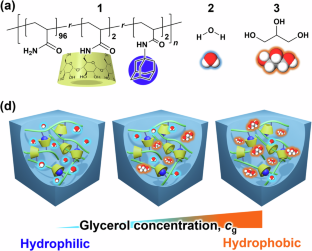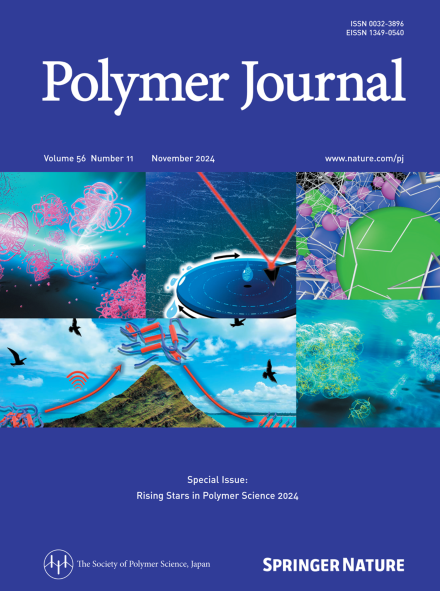Viscoelastic behaviors for optimizing self-healing of gels with host–guest inclusion complexes
IF 2.3
4区 化学
Q3 POLYMER SCIENCE
引用次数: 0
Abstract
This research showed that the self-healing properties of reversible crosslinked gels with host–guest inclusion complexes depended on the mobility of network chains and the recombination behaviors of reversible complexes, which were affected by changes in the water–glycerol solvent composition. The sticky reptation behaviors of the polymer chains were delayed by the recombination behaviors of reversible bonds. These behavioral characteristics were observed based on a dynamic viscoelasticity. Increasing the glycerol concentration in the mixed solvent decreased the surface tension and increased the mobility of the network chains because the recombination of the complex was slowed by the weak hydrophobic interactions between the host and guest molecules. Consequently, self-healing properties, such as re-adhesion at the cutting surface, were improved by the interdiffusion of polymer chains at the reattached interface. The strong hydrophobic interactions in pure water promoted the formation of complexes within the same cutting surface, thus decreasing the self-healing rates of the mechanical properties. In this study, the solvent was found to be an important parameter for controlling the self-healing properties of reversible crosslinked gels. The competition between the mobility of polymer chains and the recombination behaviors of reversible bonds controlled the self-healing properties of the gels with host–guest inclusion complexes. This study examined how changing the water-glycerol solvent composition affects the self-healing and viscoelastic properties of self-healing gels, which have host-guest inclusion complexes as reversible crosslinks. Increasing glycerol concentration in the mixture solvent reduced hydrophobic interactions between β-cyclodextrin and adamantane, lowering the association constant of host-guest inclusion complexes. The weakened hydrophobic interaction hinders complex recombination and enhances the mobility of the network chains. Consequently, the enhancement of mobility improved the healing ratio because the interfacial diffusion of the chains was promoted at the repair interfaces.


优化含有主客体包合物的凝胶自愈合的粘弹性行为
该研究表明,具有主客体包合复合物的可逆交联凝胶的自愈合特性取决于网络链的流动性和可逆复合物的重组行为,而这两点又受到水-甘油溶剂成分变化的影响。聚合物链的粘滞重组行为受到可逆键重组行为的延迟。这些行为特征是基于动态粘弹性观察到的。混合溶剂中甘油浓度的增加降低了表面张力,增加了网络链的流动性,这是因为主分子和客分子之间微弱的疏水相互作用减缓了复合物的重组。因此,聚合物链在重新附着的界面上相互扩散,从而改善了自愈合特性,如切割表面的重新附着。纯水中强烈的疏水相互作用会促进在同一切割表面形成复合物,从而降低机械性能的自愈率。本研究发现,溶剂是控制可逆交联凝胶自愈合特性的一个重要参数。聚合物链的流动性与可逆键的重组行为之间的竞争控制着具有主客体包合复合物的凝胶的自愈合特性。
本文章由计算机程序翻译,如有差异,请以英文原文为准。
求助全文
约1分钟内获得全文
求助全文
来源期刊

Polymer Journal
化学-高分子科学
CiteScore
5.60
自引率
7.10%
发文量
131
审稿时长
2.5 months
期刊介绍:
Polymer Journal promotes research from all aspects of polymer science from anywhere in the world and aims to provide an integrated platform for scientific communication that assists the advancement of polymer science and related fields. The journal publishes Original Articles, Notes, Short Communications and Reviews.
Subject areas and topics of particular interest within the journal''s scope include, but are not limited to, those listed below:
Polymer synthesis and reactions
Polymer structures
Physical properties of polymers
Polymer surface and interfaces
Functional polymers
Supramolecular polymers
Self-assembled materials
Biopolymers and bio-related polymer materials
Polymer engineering.
 求助内容:
求助内容: 应助结果提醒方式:
应助结果提醒方式:


